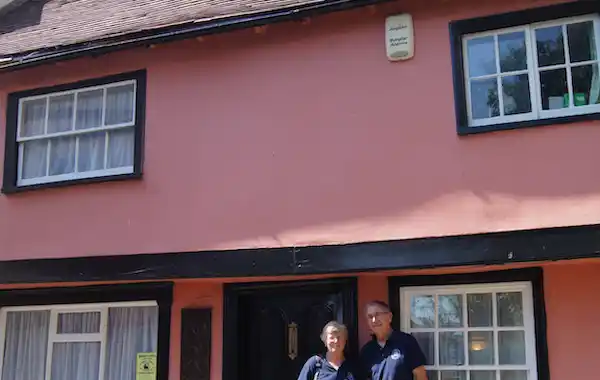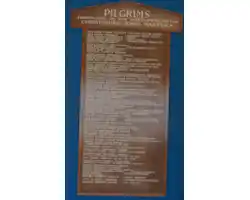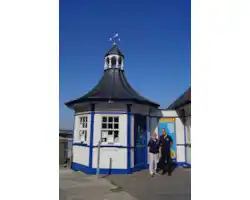Four centuries ago the Mayflower Pilgrims set sail for the New World. Discover must-see places to include when planning your trips during this upcoming Mayflower 400 commemorative year
Over the coming year, there will be a huge range of events throughout England, Holland and America, celebrating and commemorating the legacy and story of the Mayflower Pilgrims. These were people who set sail nearly 400 years ago (September 1620), bound for the New World and with hope in their hearts for freedom to live the life they chose. Being based in East Anglia, not far from ‘Pilgrim central’, and as a huge fan of anniversaries, Family Tree editor Helen Tovey thought she'd explore some of the historic stop-offs on the Mayflower 400 heritage trail.
As a family historian, the first stop had to be the record office, to find out about the papertrail treasures that had stood the test of time and could shed light on this chapter of early 17th century history. Then the plan was to take in Mayflower-related landmarks to immerse myself in the past.
One of the joys of a commemorative anniversary is the opportunity it provides to dig deeper and revel in an era of history and family history that we might not usually look at so closely. The early 1600s – the decades during which the events leading up to the sailing of the Mayflower unfurled – are a fascinating era for just such study. They’re an era for which many family history records survive, and an era about which much history is known – so there’s a great deal to dive in and learn about.
Over at ‘About Mayflower 400’ we’ve given an overview of the Mayflower story and legacy, a summary of all the places involved, a list of some of the key Mayflower pilgrims and families. Here is just a snapshot of the Mayflower heritage locations I’ve taken in so far.
First stop: Essex Record Office
Archivist Lawrence Barker and the team at Essex Record Office, Chelmsford, have been scouring the 8 miles of shelving and 16 million documents in the archives and have unearthed documentary delights related to the Mayflower story.
In addition to OS and tithe maps to help you get the lie of the land, there, amongst the inky names on the parish registers, are the entries for Christopher Jones (none other than the Captain of the Mayflower) marrying his sweetheart Sara Twitt in on 27 December 1594.
Manorial records for Great Burstead show Christopher Martin, as do the Archdeacon’s Acts Books. In the latter it’s recorded that Christopher Martin refused to kneel when taking Communion – a distinct sign of Dissenting behaviour, and sure enough, Christopher Martin would go on to become one of the Mayflower Pilgrims.
Essex connections to prominent American history aren’t solely related to the Mayflower passengers, but to other early pilgrims too. The parish register for All Saints, Messing, for instance, showing Reynold Bush of Messing, who emigrated to Massachusetts in the 1630s, and who is claimed to be an ancestor of George Bush father and son.
US Presidential connections abound in Messing with the marriage of John Porter and Anne White in 1620. They emigrated to Connecticut in 1639 and were apparently ancestors of presidents Ulysses S Grant, Grover Cleveland and Gerald Ford.
With a lights and airy search room, an extensive collection of local and family history books, and a Sound & Video Archive, in addition to the wealth of 16 million documents spanning a thousand years of history, a visit to Essex Record Office is sure to be informative.
- Whether preparing for a visit, or searching solely online, the Essex Record Office website is extremely useful
- There’s an online catalogue to help you investigate its holdings and where available links through to digitised images of the original documents (via a subscription)
En route: Castle Hedingham
While in the locality it’s well worth absorbing other historical attractions. Built around 1100, Castle Hedingham is a towering Norman keep at Halstead. It wasn’t built as a military castle, but instead was erected to store the vast quantities of fines and taxes that were gathered in by the Normans. Alcoves throughout the castle would once have housed vast coffers.
As castle guide Jane Greatorex explains, the castle represents a ‘total feudal ceremony and hierarchy’ – people would have had to enter through a side door, rather than the main entrance, and an massive overhead arch still separates the lower and the upper hall, signifying the gap between subjects and rulers.
Schools and societies can book a group tour; visitors to check the website for opening hours and dates: www.hedinghamcastle.co.uk
Harwich: home of the Mayflower
For such a famous vessel, its precise origins are a little shrouded in mystery, but the Mayflower is thought to have been built in the port of Harwich. Harwich was also the home town of the Captain of the Mayflower Christopher Jones.
Christopher Jones’s home
To this day his home is still standing in King’s Head Street, and in the months to come it’ll be possible to visit. I was lucky enough to step inside. Looking out of the upstairs window, across the narrow street to the Alma Inn & Dining Rooms (well worth a pit-stop), you can see what was once the bedroom of Jones’s neighbour, sweetheart and future wife Sara Twitt. In Jones’s time the Quay would have been much closer, and it’s all too easy to imagine him slinging his sea-chest on his shoulder, and striding off down a bustling street, and setting sail.
The Harwich Society
The Harwich Society is an asset to the town, and their website is a mine of local historical info. There are maps, a gallery and an audio tour to help you explore Harwich’s heritage. Well worth investigating are the tours offered by the society too. Chairman Colin Farnell and his wife Aileen showed me some of the Harwich highlights. Complete with amusing and quirky anecdotes, and on-hand to answer any questions, they transformed my walking tour of Harwich – guides I’d thoroughly recommend to get the most out of your visit, and packed with intriguing snippets of history. Did you know for instance, that the High and Low Lighthouses in Harwich were placed so that sailors could use them to navigate home? Known as ‘leading lights’, ships would line up the two lights, one above the other, and thus know they were on a safe course in.
Other historic highlights of Harwich include the vast Redoubt, built in 1808 to help defend the town against the threat of invasion by Napoleon, and the Treadwheel Crane, built in 1667 on the site of the Naval Yard, and the only British example of a two-wheel man operated treadwheel crane.
- To find the full listing of 21 Historic Harwich attractions see the society website
Tip! Find out more about exploring Historic Harwich and planning your Mayflower trips at Historical Harwich and Mayflower 400
Ha’penny Pier & The Pier Hotel
The Ha’penny Pier is still a bustling pier with boats bobbing below, people fishing, and others relaxing and taking in the view. Across the water Felixstowe is busy and vast, ocean-going container ships being loaded and unloaded – and in complete contrast to the quaint narrow streets of historic Harwich, and the time of the Mayflower.
To really soak up the atmosphere at stay at The Pier puts you right in the action. Situated on the quay, you can enjoy an evening meal on the balcony overlooking the sunset on the water, and turn in for the night, perhaps treating yourself to the Mayflower Suite, complete with telescope for perusing the stunning seascape view.
Getting out in a boat - Harwich from the sea
Being this close to the sea and not getting out in a boat is not an option! But it’s a mission easily accomplished, allowing you to take in the coast and get some natural history too. Take the Gloria on a trip from Harwich Ha’Penny Pier up to Hamford Water. Lasting about 2 hours, you’ll get the chance to feel the sea breeze on your skin, see seals (and maybe their pups too) and get a taste for the life at sea that our Mayflower Pilgrims would have recognised all too well in their time.
Your Mayflower trip
One of the boons of family history, and history generally, is the fabulous excuse it gives to get out and about and explore places you’ve never visited before. We hope the tips above have given you ideas of where you might visit during this upcoming Mayflower 400 commemorative year. And for other Mayflower 400 hot spots see our article here.























.jpg)